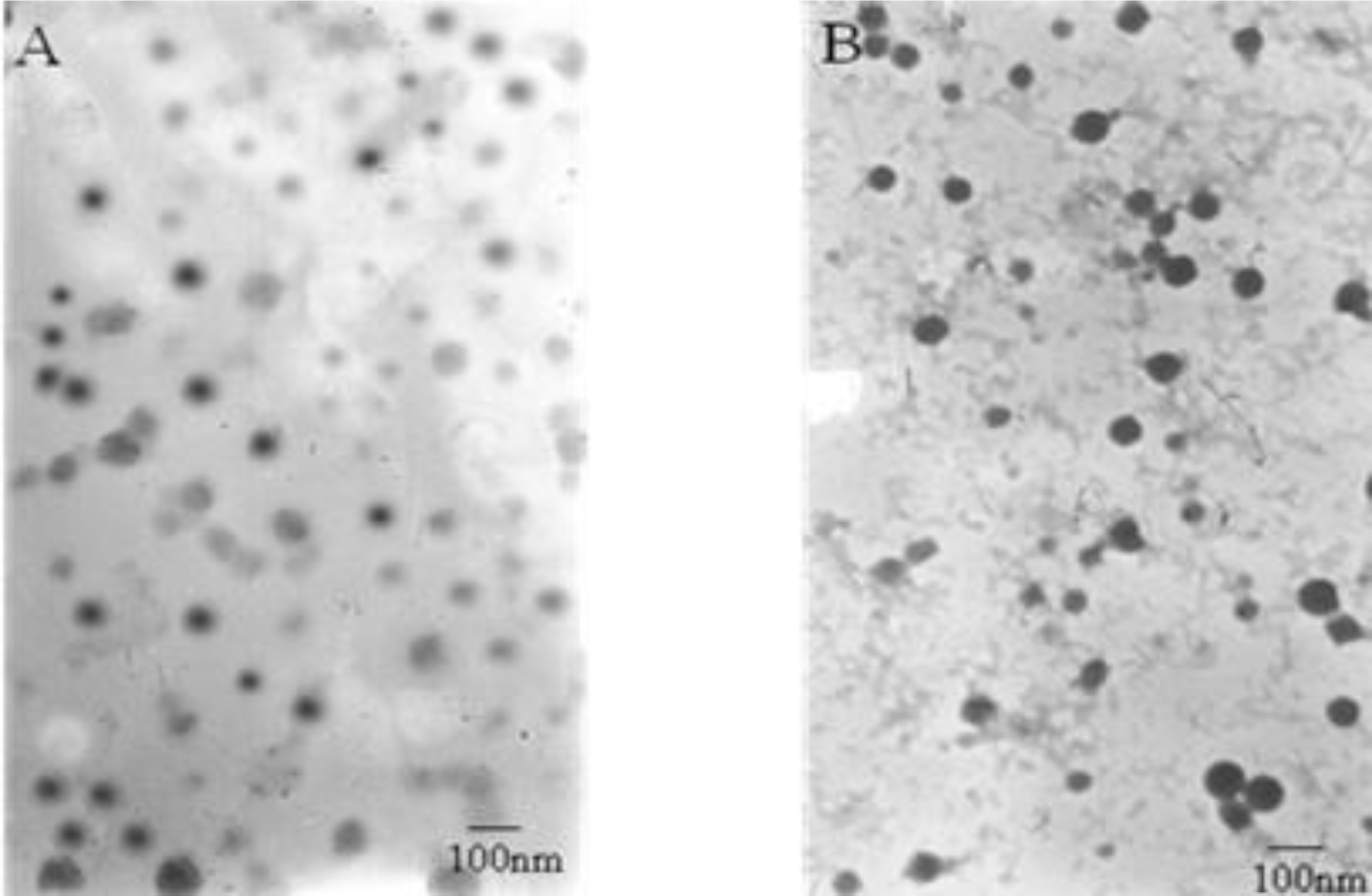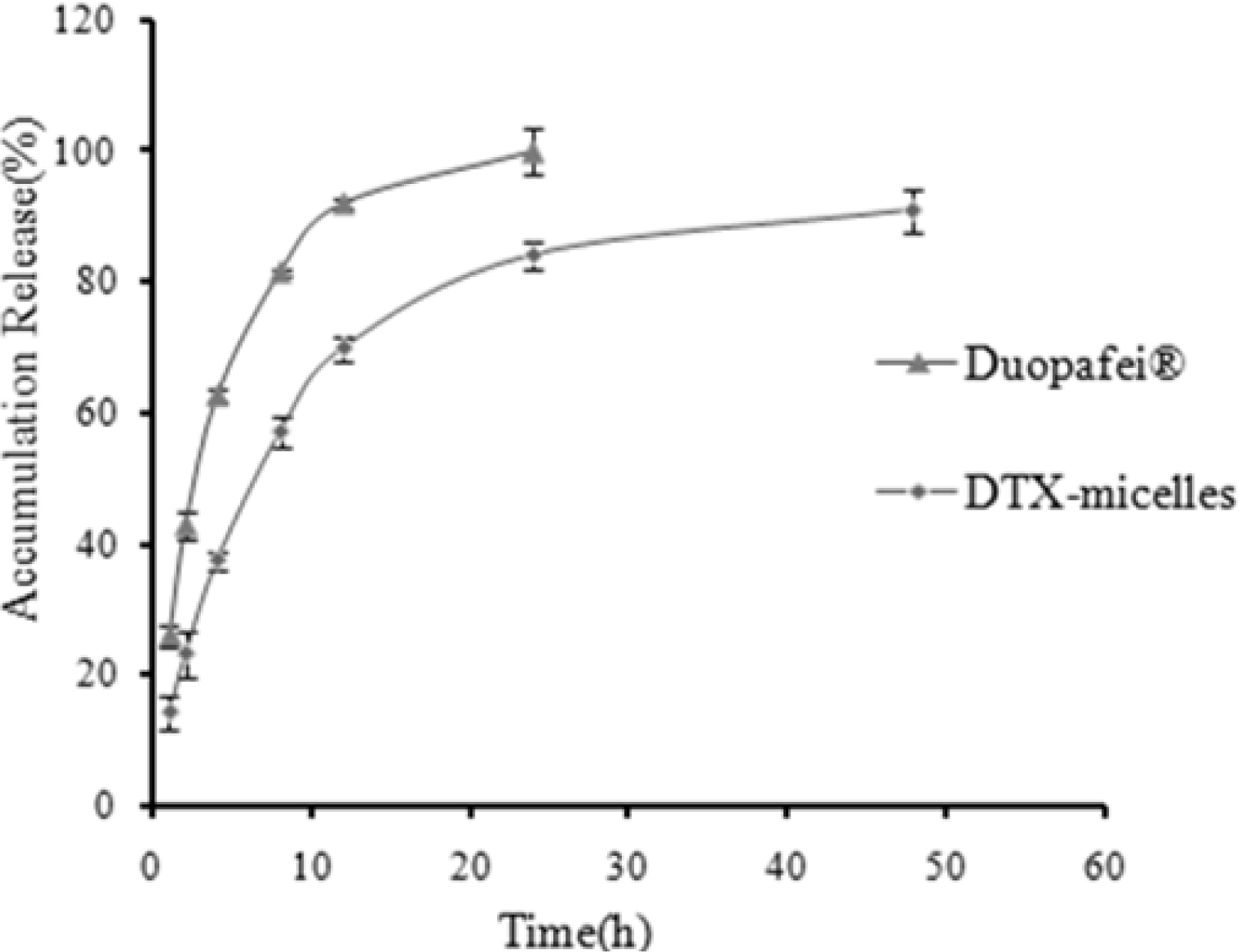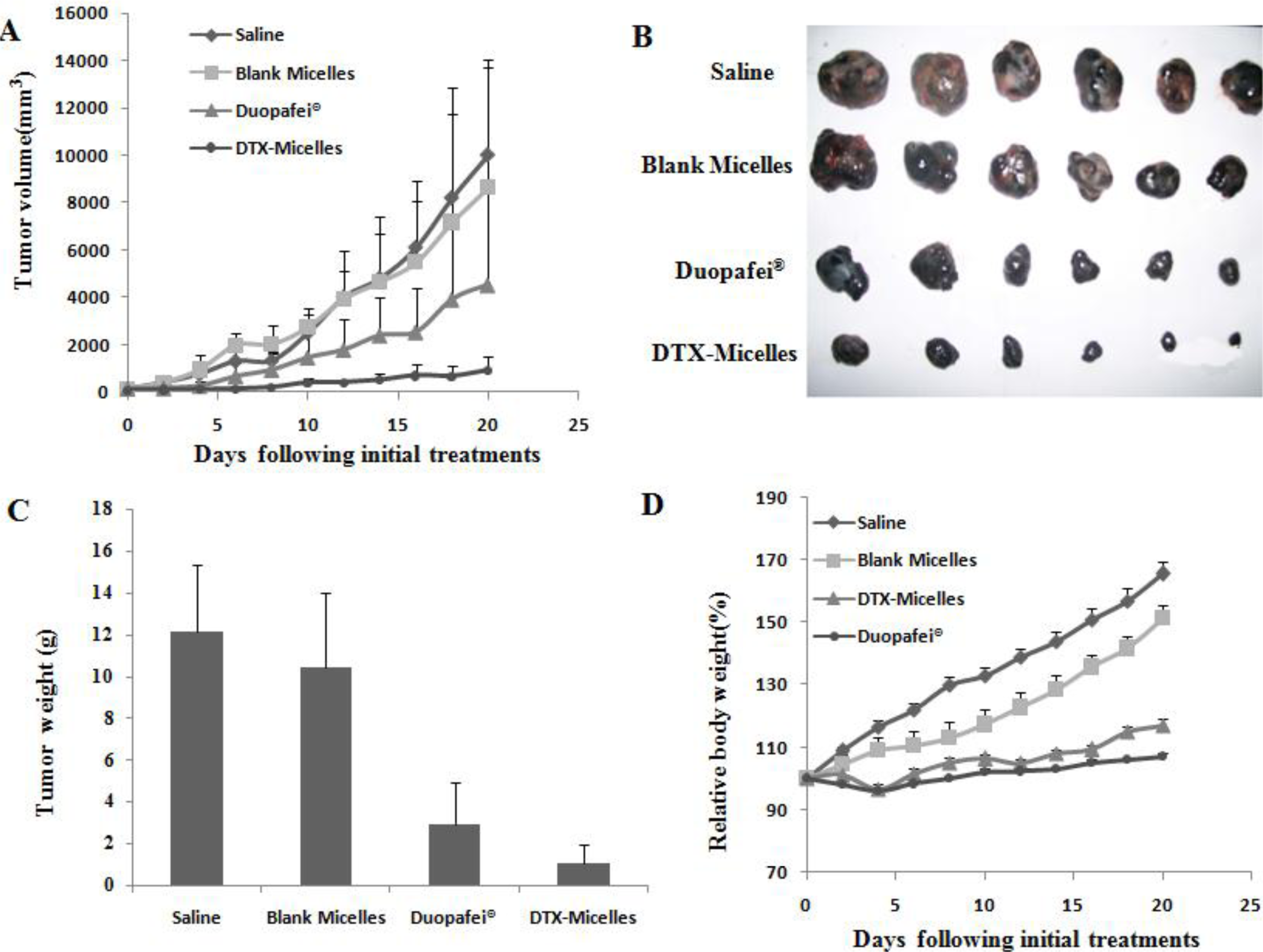Docetaxel-Loaded Pluronic P123 Polymeric Micelles: in Vitro and in Vivo Evaluation
Abstract
:1. Introduction
2. Results and Discussion
2.1. Preparation of DTX-Micelles
2.2. Physicochemical Characterization of DTX-Micelles
2.3. In Vitro Drug Release
2.4. In Vitro Cytotoxic Activity
2.5. In Vivo Tumor Growth Inhibition Study
3. Materials and Methods
3.1. Materials
3.2. Animals
3.3. Preparation of DTX-Micelles
3.4. Determination of Docetaxel Content in Micelles
3.5. Physicochemical Characterization of DTX-Micelles
3.6. In Vitro Release Studies
3.7. In Vitro Cytotoxic Activity
3.8. In Vivo Tumor Growth Inhibition Study
3.9. Statistical Analysis
4. Conclusions
Acknowledgments
References
- Richard Pazdur, APK; Kavanagh, JJ; Cohen, PR; Raber, MN. The taxoids: Paclitaxel(Taxol®) and docetaxel(Taxotere®). Cancer Treat. Rev 1993, 19, 351–386. [Google Scholar]
- Cortes, JE; Pazdur, R. Docetaxel. J. Clin. Oncol 1995, 13, 2643–2655. [Google Scholar]
- Chevallier, B; Fumoleau, P; Kerbrat, P; Dieras, V; Roche, H; Krakowski, I; Azli, N; Bayssas, M; Lentz, MA; Van Glabbeke, M. Docetaxel is a major cytotoxic drug for the treatment of advanced breast cancer: A phase II trial of the Clinical Screening Cooperative Group of the European Organization for Research and Treatment of Cancer. J. Clin. Oncol 1995, 13, 314–322. [Google Scholar]
- Ravdin, PM; Burris, HA; Cook, G; Eisenberg, P; Kane, M; Bierman, WA; Mortimer, J; Genevois, E; Bellet, RE. Phase II trial of docetaxel in advanced anthracycline-resistant or anthracenedione-resistant breast cancer. J. Clin. Oncol 1995, 13, 2879–2885. [Google Scholar]
- Valero, V; Holmes, FA; Walters, RS; Theriault, RL; Esparza, L; Fraschini, G; Fonseca, GA; Bellet, RE; Buzdar, AU; Hortobagyi, GN. Phase II trial of docetaxel: A new, highly effective antineoplastic agent in the management of patients with anthracycline-resistant metastatic breast cancer. J. Clin. Oncol 1995, 13, 2886–2894. [Google Scholar]
- Fossella, FV; Lee, JS; Shin, DM; Calayag, M; Huber, M; Perez-Soler, R; Murphy, WK; Lippman, S; Benner, S; Glisson, B. Phase II study of docetaxel for advanced or metastatic platinum-refractory non-small-cell lung cancer. J. Clin. Oncol 1995, 13, 645–651. [Google Scholar]
- Kaye, SB; Piccart, M; Aapro, M; Francis, P; Kavanagh, J. Phase II trials of docetaxel (Taxotere®) in advanced ovarian cancer-an updated overview. Eur. J. Cancer 1997, 33, 2167–2170. [Google Scholar]
- Androulakis, N; Kourousis, C; Kakolyris, S; Sarra, E; Kalbakis, K; Kalikaki, T; Kois, S; Vardakis, N; Samonis, G; Georgoulias, V. Monotherapy with docetaxel and granulocyte colony-stimulating factor in advanced gastric cancer. Ann. Oncol 1998, 9, 54. [Google Scholar]
- Couteau, C; Chouaki, N; Leyvraz, S; Oulid-Aissa, D; Lebecq, A; Domenge, C; Groult, V; Bordessoule, S; Janot, F; De Forni, M; Armand, JP. A phase II study of docetaxel in patients with metastatic squamous cell carcinoma of the head and neck. Br. J. Cancer 1999, 81, 457–462. [Google Scholar]
- Friedland, D; Cohen, J; Miller, R; Voloshin, M; Gluckman, R; Lembersky, B; Zidar, B; Keating, M; Reilly, N; Dimitt, B. A phase II trial of docetaxel (Taxotere) in hormone-refractory prostate cancer: Correlation of antitumor effect to phosphorylation of Bcl-2. Semin. Oncol 1999, 26, 19–23. [Google Scholar]
- Zhang, W; Yuan, S; Chen, YZ; Yu, SY; Hao, JG; Luo, JQ; Sha, XY; Fang, XL. Enhanced antitumor efficacy by Paclitaxel-loaded Pluronic P123/F127 mixed micelles against non-small cell lung cancer based on passive tumor targeting and modulation of drug resistance. Eur. J. Pharm. Biopharm 2010, 75, 341–353. [Google Scholar]
- Engels, FK; Mathot, RA; Verweij, J. Alternative drug formulations of docetaxel: A review. Anticancer Drugs 2007, 18, 95–103. [Google Scholar]
- Yanasarn, N; Sloat, BR; Cui, Z. Nanoparticles engineered from lecithin-in-water emulsions as a potential delivery system for docetaxel. Int. J. Pharm 2009, 379, 174–180. [Google Scholar]
- Baker, J; Ajani, J; Scotte, F; Winther, D; Martin, M; Aapro, MS; Minckwitz, GV. Docetaxel-related side effects and their management. Eur. J. Oncol. Nurs 2009, 13, 49–59. [Google Scholar]
- Baker, J; Ajani, J; Scotte, F; Winther, D; Martin, M; Aapro, MS; Minckwitz, GV. Docetaxel-related side effects and their management. Eur. J. Oncol. Nurs 2008, 12, 479–479. [Google Scholar]
- Zhai, G; Wu, J; Xiang, G; Mao, W; Yu, B; Li, H; Piao, L; Lee, LJ; Lee, RJ. Preparation, characterization and pharmacokinetics of folate receptor-targeted liposomes for docetaxel delivery. J. Nanosci. Nanotech 2009, 9, 2155–2161. [Google Scholar]
- Huang, HB; Liu, T; Lin, ZC; Zhong, JT; Lin, PL; Liu, JY; Tan, YY; Li, S; Liao, H; Xu, YH. Preparation of docetaxel liposomes and their pharmacokinetics in rabbits. Ai Zheng 2007, 26, 1287–1291. [Google Scholar]
- Immordino, ML; Brusa, P; Arpicco, S; Stella, B; Dosio, F; Cattel, L. Preparation, characterization, cytotoxicity and pharmacokinetics of liposomes containing docetaxel. J. Control. Release 2003, 91, 417–429. [Google Scholar]
- Musumeci, T; Ventura, CA; Giannone, I; Ruozi, B; Montenegro, L; Pignatello, R; Puglisi, G. PLA/PLGA nanoparticles for sustained release of docetaxel. Int. J. Pharm 2006, 325, 172–179. [Google Scholar]
- Yin, YM; Cui, FD; Mu, CF; Choi, MK; Kim, JS; Chung, SJ; Shim, CK; Kim, DD. Docetaxel microemulsion for enhanced oral bioavailability: Preparation and in vitro and in vivo evaluation. J. Control. Release 2009, 140, 86–94. [Google Scholar]
- Gao, K; Sun, J; Liu, K; Liu, X; He, Z. Preparation and characterization of a submicron lipid emulsion of docetaxel: Submicron lipid emulsion of docetaxel. Drug Dev. Ind. Pharm 2008, 34, 1227–1237. [Google Scholar]
- Esmaeili, F; Dinarvand, R; Ghahremani, MH; Amini, M; Rouhani, H; Sepehri, N; Ostad, SN; Atyabi, F. Docetaxel-albumin conjugates: Preparation, in vitro evaluation and biodistribution studies. J. Pharm. Sci 2009, 98, 2718–2730. [Google Scholar]
- Liu, J; Zahedi, P; Zeng, F; Allen, C. Nano-sized assemblies of a PEG-docetaxel conjugate as a formulation strategy for docetaxel. J. Pharm. Sci 2008, 97, 3274–3290. [Google Scholar]
- Xie, ZG; Lu, TC; Chen, XS; Zheng, YH; Jing, XB. Synthesis, self-assembly in water, and cytotoxicity of MPEG-block-PLLA/DX conjugates. J. Biomed. Mater. Res. A 2009, 88A, 238–245. [Google Scholar]
- Mikhail, AS; Allen, C. Block copolymer micelles for delivery of cancer therapy: Transport at the whole body, tissue and cellular levels. J. Control. Release 2009, 138, 214–223. [Google Scholar]
- Nishiyama, N; Kataoka, K. Current state, achievements, and future prospects of polymeric micelles as nanocarriers for drug and gene delivery. Pharmacol. Ther 2006, 112, 630–648. [Google Scholar]
- Bae, Y; Kataoka, K. Intelligent polymeric micelles from functional poly (ethylene glycol)–poly (amino acid) block copolymers. Adv. Drug Deliv. Rev 2009, 61, 768–784. [Google Scholar]
- Gaucher, G; Dufresne, MH; Sant, VP; Kang, N; Maysinger, D; Leroux, JC. Block copolymer micelles: Preparation, characterization and application in drug delivery. J. Control. Release 2005, 109, 169–188. [Google Scholar]
- Lukyanov, AN; Torchilin, VP. Micelles from lipid derivatives of water-soluble polymers as delivery systems for poorly soluble drugs. Adv. Drug Deliv. Rev 2004, 56, 1273–1289. [Google Scholar]
- Elsabahy, M; Perron, ME; Bertrand, N; Yu, GE; Leroux, JC. Solubilization of docetaxel in poly(ethylene oxide)-block-poly(butylene/styrene oxide) micelles. Biomacromolecules 2007, 8, 2250–2257. [Google Scholar]
- Mikhail, AS; Allen, C. Poly(ethylene glycol)-b-poly(epsilon-caprolactone) micelles containing chemically conjugated and physically entrapped docetaxel: Synthesis, characterization, and the influence of the drug on micelle morphology. Biomacromolecules 2010, 11, 1273–1280. [Google Scholar]
- Batrakova, EV; Li, S; Li, YL; Alakhov, VY; Elmquist, WF; Kabanov, AV. Distribution kinetics of a micelle-forming block copolymer Pluronic P85. J. Control. Release 2004, 100, 389–397. [Google Scholar]
- Zhang, W; Hao, JG; Yuan, S; Li, YJ; Juan, W; Sha, XY; Fang, XL. Paclitaxel-loaded Pluronic P123/F127 mixed polymeric micelles: Formulation, optimization and in vitro characterization. Int. J. Pharm 2009, 376, 176–185. [Google Scholar]
- Han, LM; Guo, J; Zhang, LJ; Wang, QS; Fang, XL. Pharmacokinetics and biodistribution of polymeric micelles of paclitaxel with pluronic P123. Acta Pharmacol. Sin 2006, 27, 747–753. [Google Scholar]
- Kabanov, AV; Batrakova, EV; Alakhov, VY. Pluronic® block copolymers as novel polymer therapeutics for drug and gene delivery. J. Control. Release 2002, 82, 189–212. [Google Scholar]
- Foster, B; Cosgrove, T; Hammouda, B. Pluronic triblock copolymer systems and their interactions with ibuprofen. Langmuir 2009, 25, 6760–6766. [Google Scholar]
- Bae, YH; Yin, HQ. Stability issues of polymeric micelles. J. Control. Release 2008, 131, 2–4. [Google Scholar]
- Mu, L; Teo, MM; Ning, HZ; Tan, CS; Feng, SS. Novel powder formulations for controlled delivery of poorly soluble anticancer drug: Application and investigation of TPGS and PEG in spray-dried particulate system. J. Control. Release 2005, 103, 565–575. [Google Scholar]
- Dong, PW; Wang, XH; Gu, YC; Wang, YJ; Wang, YJ; Gong, CY; Luo, F; Guo, G; Zhao, X; Wei, YQ; Qian, ZY. Self-assembled biodegradable micelles based on star-shaped PCL-b-PEG copolymers for chemotherapeutic drug delivery. Colloid. Surface A 2010, 358, 128–134. [Google Scholar]
- Danhier, F; Magotteaux, N; Ucakar, B; Lecouturier, N; Brewster, M; Preat, V. Novel self-assembling PEG-p-(CL-co-TMC) polymeric micelles as safe and effective delivery system for Paclitaxel. Eur. J. Pharm. Biopharm 2009, 73, 230–238. [Google Scholar]
- Jones, M; Leroux, J. Polymeric micelles—A new generation of colloidal drug carriers. Eur. J. Pharm. Biopharm 1999, 48, 101–111. [Google Scholar]
- Matsumura, Y. Preclinical and clinical studies of NK012, an SN-38-incorporating polymeric micelles, which is designed based on EPR effect. Adv. Drug Deliv. Rev 2010, in press. [Google Scholar]
- Torchilin, V. Tumor delivery of macromolecular drugs based on the EPR effect. Adv. Drug Deliv. Rev 2010, in press. [Google Scholar]
- De Jong, WH; Borm, PJA. Drug delivery and nanoparticles: Applications and hazards. Int. J. Nanomedicine 2008, 3, 133–149. [Google Scholar]
- Chen, WQ; Wei, H; Li, SL; Feng, J; Nie, J; Zhang, XZ; Zhuo, RX. Fabrication of star-shaped, thermo-sensitive poly(N-isopropylacrylamide)-cholic acid-poly(epsilon-caprolactone) copolymers and their self-assembled micelles as drug carriers. Polymer 2008, 49, 3965–3972. [Google Scholar]
- Mosmann, T. Rapid colorimetric assay for cellular growth and survival: Application to proliferation and cytotoxicity assays. J. Immunol. Meth 1983, 65, 55–63. [Google Scholar]
- Danhier, F; Lecouturier, N; Vroman, B; Jerome, C; Marchand-Brynaert, J; Feron, O; Preat, V. Paclitaxel-loaded PEGylated PLGA-based nanoparticles: In vitro and in vivo evaluation. J. Control. Release 2009, 133, 11–17. [Google Scholar]
- Zheng, DH; Li, XL; Xu, HE; Lu, XW; Hu, Y; Fan, WX. Study on docetaxel-loaded nanoparticles with high antitumor efficacy against malignant melanoma. Acta Biochim. Biophys. Sin 2009, 41, 578–587. [Google Scholar]
- Zhao, ZM; He, M; Yin, LC; Bao, JM; Shi, LL; Wang, BQ; Tang, C; Yin, CH. Biodegradable nanoparticles based on linoleic acid and poly(beta-malic acid) double grafted chitosan derivatives as carriers of anticancer drugs. Biomacromolecules 2009, 10, 565–572. [Google Scholar]




| Treatment type | IC50 values (μM) | ||
|---|---|---|---|
| on HepG2 cells | on A549 cells | on B16 cells | |
| Duopafei® | 0.96 ± 0.05 | 0.74 ± 0.02 | 0.72 ± 0.10 |
| DTX-micelles | 0.34 ± 0.02** | 0.44 ± 0.05* | 0.49 ± 0.08** |
| Blank micelles | 12.84 ± 0.12 | 29.62 ± 1.02 | 13.79 ± 0.24 |
| Formulation | Tumor weight x ± SD(g) | Tumor inhibition rate (%) | Pa |
|---|---|---|---|
| Saline | 12.18 ± 3.20 | N.A. | N.A. |
| Blank micelles | 10.43 ± 3.59 | 14.4 | N.A. |
| Duopafei® | 2.89 ± 2.04 | 76.3 | <0.01 |
| DTX- micelles | 1.02 ± 0.91 | 91.6 | <0.01 |
© 2011 by the authors; licensee MDPI, Basel, Switzerland. This article is an open-access article distributed under the terms and conditions of the Creative Commons Attribution license (http://creativecommons.org/licenses/by/3.0/).
Share and Cite
Liu, Z.; Liu, D.; Wang, L.; Zhang, J.; Zhang, N. Docetaxel-Loaded Pluronic P123 Polymeric Micelles: in Vitro and in Vivo Evaluation. Int. J. Mol. Sci. 2011, 12, 1684-1696. https://doi.org/10.3390/ijms12031684
Liu Z, Liu D, Wang L, Zhang J, Zhang N. Docetaxel-Loaded Pluronic P123 Polymeric Micelles: in Vitro and in Vivo Evaluation. International Journal of Molecular Sciences. 2011; 12(3):1684-1696. https://doi.org/10.3390/ijms12031684
Chicago/Turabian StyleLiu, Zhihong, Donghua Liu, Lili Wang, Juan Zhang, and Na Zhang. 2011. "Docetaxel-Loaded Pluronic P123 Polymeric Micelles: in Vitro and in Vivo Evaluation" International Journal of Molecular Sciences 12, no. 3: 1684-1696. https://doi.org/10.3390/ijms12031684




